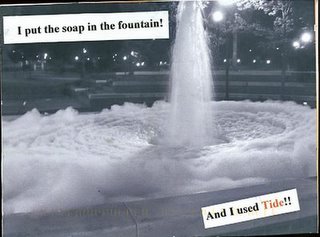Thursday, December 15, 2005
In Case You Were Wondering...
A computer has concluded that the Mona Lisa was "mostly happy." I am so glad the computer cleared this up for us. This has profound implications for the fields of psychology and psychiatry.
People Really Need to "Lighten" Up
Look, I understand that not all of us have a dark sense of humor, but I do think people should still at least try to appreciate a good joke, dark or not. What can you do?
Some people are up in arms about this holiday display. I think it's pretty funny and as close to a true artistic statement as Christmas lights can approach.



Some people are up in arms about this holiday display. I think it's pretty funny and as close to a true artistic statement as Christmas lights can approach.



Some important points to make:
1. I say the above and I STILL am an animal lover.
2. Rudolph is a fictitious and at best, cartoon character.
3. They are fake deer made from lights.
Just my two cents.
Wednesday, December 14, 2005
Of Penguins and Men
 This past weekend, I watched "March of the Penguins." I am often accused of anthropomorphizing animals by those who think animals are all reflexes and biological instincts with no consciousness or feelings. I don't know how someone with such beliefs could continue to believe in such a way after seeing the film. It is clear that animals feel and have fealty, express loyalty, and experience grief and pain. The story of the mating ritual of these emperor penguins makes these realities abundantly clear--whether you see a penguin show tendernous and commitment to another penguin and their offspring, or whether you see the penguins who survive the arduous journey stand (sadly) over one of their fallen comrades or young, or watch a bereaved mother penguin actually try to steal another's young. Some animals are really no different than us, even though they can't grasp with a thumb and use tools or verbally express themselves through human languages. Perhaps those things aren't important in the end anyway if we are all the same at the core. I highly recommend the film. It was amazing, educational, and touching.
This past weekend, I watched "March of the Penguins." I am often accused of anthropomorphizing animals by those who think animals are all reflexes and biological instincts with no consciousness or feelings. I don't know how someone with such beliefs could continue to believe in such a way after seeing the film. It is clear that animals feel and have fealty, express loyalty, and experience grief and pain. The story of the mating ritual of these emperor penguins makes these realities abundantly clear--whether you see a penguin show tendernous and commitment to another penguin and their offspring, or whether you see the penguins who survive the arduous journey stand (sadly) over one of their fallen comrades or young, or watch a bereaved mother penguin actually try to steal another's young. Some animals are really no different than us, even though they can't grasp with a thumb and use tools or verbally express themselves through human languages. Perhaps those things aren't important in the end anyway if we are all the same at the core. I highly recommend the film. It was amazing, educational, and touching.
Sunday, December 11, 2005
I Blame "Timer"
Anyone who knows me knows that I can't stand cheddar cheese. It's not an allergy and I didn't have a bad experience with the stuff. I just have an automatic gag reflex when I smell it or taste it in even the most minute amounts. Yet, I've had to live in a culture (no pun intended) that worships cheddar. It's almost literally in every American food. People are aghast when they find out that I despise cheddar cheese and try to "convert" me. Tonight, I had a revelation about who's to blame for this mania for cheese. I blame the humorous cartoon with the catchy song. I blame the character named "Timer...."


Saturday, December 10, 2005
Friday, December 09, 2005
Revisiting an Old Favorite: Cat Wranglin'
If I live a thousand years, there will never be a better commercial than this one by EDS. In my teaching and administrative positions, it has stood as a symbol of working with artists.
Chivalry Isn't Dead
This weekend is a special weekend for me. One of my favorite stories of all time comes to theaters. I'm sure you've probably heard more than your share of p.r. about The Chronicles of Narnia: The Lion, the Witch, and the Wardrobe, but I'll still share my story in relation to the book. From the time I was 7 to 29, I had a personal tradition of reading the book every November. I started it when I was seven because I was captivated by the story-telling and the imagery, so much so that I would sit in my grandfather's wardrobe and wait for the back to open up into a whole other world, while people were in the other room socializing. I would sit there for a long time, smelling the cherry wood and grandpa's clothes, and I would close my eyes and push on the back and hope against hope that something would open up, and I would be near the lamp post and greeted by Mr. Tumnus, the faun. Obviously, that didn't happen.
 1979 was also the first time I saw a film adaptation of the story--or rather, a cartoon. It was very groovy, but not very satisfying overall. Something about the cartoon genre, simple doesn't do the imagination justice. It was a Children's Television Workshop (the same people who bring us Sesame Street) production and was shown on primetime television. It was quirky, and choppy, and all the characters were wearing bell-bottoms (because that was the fashion trend in Narnia).
1979 was also the first time I saw a film adaptation of the story--or rather, a cartoon. It was very groovy, but not very satisfying overall. Something about the cartoon genre, simple doesn't do the imagination justice. It was a Children's Television Workshop (the same people who bring us Sesame Street) production and was shown on primetime television. It was quirky, and choppy, and all the characters were wearing bell-bottoms (because that was the fashion trend in Narnia).
Later, in 1988, I got my hopes up to see a BBC production of the story on PBS. Ultimately, I was very disappointed because the animatronics were just plain sad. The cast was really the best thing about that production, especially the White Witch, who was played by Barbara Kellerman.
© Stephanie Lewis, 2005
 1979 was also the first time I saw a film adaptation of the story--or rather, a cartoon. It was very groovy, but not very satisfying overall. Something about the cartoon genre, simple doesn't do the imagination justice. It was a Children's Television Workshop (the same people who bring us Sesame Street) production and was shown on primetime television. It was quirky, and choppy, and all the characters were wearing bell-bottoms (because that was the fashion trend in Narnia).
1979 was also the first time I saw a film adaptation of the story--or rather, a cartoon. It was very groovy, but not very satisfying overall. Something about the cartoon genre, simple doesn't do the imagination justice. It was a Children's Television Workshop (the same people who bring us Sesame Street) production and was shown on primetime television. It was quirky, and choppy, and all the characters were wearing bell-bottoms (because that was the fashion trend in Narnia).Later, in 1988, I got my hopes up to see a BBC production of the story on PBS. Ultimately, I was very disappointed because the animatronics were just plain sad. The cast was really the best thing about that production, especially the White Witch, who was played by Barbara Kellerman.
This weekend, however, the film finally comes to life, thanks to C.G.I and Disney. I'm glad Disney is making this film, but I had wished Peter Jackson would have done it, but I'm sure he was more than busy with re-making another one of my favorite stories in film (and I'm sure by this point, he's medievaled-out). What I have seen of this film in previews is spectacular and just how I have imagined it over the span of my life. I know it will add to my enjoyment of my next reading of the story, and not take away from it.
In 7th grade, at the Lutheran school I attended, our English teacher had us read the story and dissect it according to Christian iconography. I still remember what he taught us (he was that good of a teacher), but I could take or leave the interpretation because I felt the story stood well on its own, just as an adventure and a fantasy. So, with this in mind, I was not surprised that the mainline evangelical protestant churches were latching onto this film and even having their own special showings in their own congregations. It has always been common belief in these churches that the books were chock full of Christian symbolism and that C.S. Lewis is one of the Christian churches most famous converts from atheism (The book he wrote about his conversion is titled, "Surprised by Joy."). There are several points to make (not to undervalue the symbolism) regarding these issues. One is that the archetypes found in The Lion, the Witch, and the Wardrobe, are not only connected with the archetypes in Christianity, but those same Christian archetypes are also found in other religions and mythologies. Another point to make is that C.S. Lewis was really always interested in chivalry. He was interested in it before he became a Christian. The philosophy of Medieval Chivalry itself is derived from early Church doctrine regarding the sacrifice of Christ (the hero/knight) for the bride (church/maiden). Epic quests and battles are always included in the medieval stories of chivalry. There is also magic (miracles). So, in a way, C.S. Lewis's interest in chivalry may have paved the way for him to develop his view of Christianity.
It is also no surpise that the film is so wildly popular with mainline evangelicals at this point in history, because of their (not all of the churches, but a lot) current focus on battles and the "end times" (which one could argue is a psychological outgrowth of living in a country at war in the first place). The story is about a final battle between good and evil and the return of a King. Technically, in terms of religious cultural history, this film couldn't have come out at a better time. I'm 100% certain that Disney will make a mint (yet again) on this film.
All of this being said, I am still glad that it is being done for my own personal, nostalgic reasons. I'm going to avoid the rush this weekend and see it next weekend with a friend and I can't wait. Here are some pictures from the film:




 I honestly don't think there is a better choice for the White Witch than Tilda Swinton.
I honestly don't think there is a better choice for the White Witch than Tilda Swinton.

Read a biography of C.S. Lewis's life here.
See this movie if you haven't yet.
© Stephanie Lewis, 2005
Thursday, December 08, 2005
Monday, December 05, 2005
Postsecret

I added another link to my links at right. The site is called Postsecret. It's VERY interesting and sometimes moving and a site you can check again and again. Be forewarned: some of the language, information, and imagery may be objectionable to some.
Sunday, December 04, 2005
My Favorite Painting of ALL Time
by Artemesia Gentileschi, oil; 72.5" x 55.75"
(click picture to enlarge)
(click picture to enlarge)
One of the most common questions I get as an artist/art teacher is "What is your favorite piece of art of all time?" You'd think that this would be a very difficult question to answer, but until I change my mind, this painting by Artemesia Gentileschi is the one for me.
First, you have to know the story of Judith. Click here to read an article on her on wikipedia.org. Consider the size of the painting. It is life size. Imagine coming upon this image in the museum and your eye level is just about where Judith's hand that holds the sword is. Can you avoid feeling like you've stumbled onto a homicide in progress with the dramatic lighting and the blood red curtain in the background? Judith holds out her hand as if to tell her maidservant to be quiet or to block the light from revealing her face. There are a series of interlocking compositional diagonals of light and shadow as well as the position of the figures' limbs and drapery that simultaneously imply action and the nervous stability of being frozen where you stand. Holofernes is barely a "participant" in this composition. His lifeless head is all that is left of him and lies parallel to the horizontal bottom edge of the painting. Judith's maidservant is in the process of bagging or covering the man's head before someone catches the women. Both women are determined yet dispassionate.
The picture has a high degree of realism until you look closer. If the tiny flame on the candle is the only source of light, then it is putting out far more light than is actually physically possible. Also, the placement of the candle is confusing. Is it to Judith's right? Or is it in front of her? The placement of her left hand in relation to the candle creates confusing space in which the candle is both beside her and ahead of her, but the light on her hand indicates it should be straight ahead of her. One can only assume the artist used a second source of light based on these facts and the fact that more of a shadow should be cast by Judith onto her maidservant if the candle is the sole source of light. This slight tweak of space and light enhances the tension of the image. With these idiosyncrasies, this image has captured my attention for a long time with its dramatic lighting, its expression of time, and its dramatic subject matter.
First, you have to know the story of Judith. Click here to read an article on her on wikipedia.org. Consider the size of the painting. It is life size. Imagine coming upon this image in the museum and your eye level is just about where Judith's hand that holds the sword is. Can you avoid feeling like you've stumbled onto a homicide in progress with the dramatic lighting and the blood red curtain in the background? Judith holds out her hand as if to tell her maidservant to be quiet or to block the light from revealing her face. There are a series of interlocking compositional diagonals of light and shadow as well as the position of the figures' limbs and drapery that simultaneously imply action and the nervous stability of being frozen where you stand. Holofernes is barely a "participant" in this composition. His lifeless head is all that is left of him and lies parallel to the horizontal bottom edge of the painting. Judith's maidservant is in the process of bagging or covering the man's head before someone catches the women. Both women are determined yet dispassionate.
The picture has a high degree of realism until you look closer. If the tiny flame on the candle is the only source of light, then it is putting out far more light than is actually physically possible. Also, the placement of the candle is confusing. Is it to Judith's right? Or is it in front of her? The placement of her left hand in relation to the candle creates confusing space in which the candle is both beside her and ahead of her, but the light on her hand indicates it should be straight ahead of her. One can only assume the artist used a second source of light based on these facts and the fact that more of a shadow should be cast by Judith onto her maidservant if the candle is the sole source of light. This slight tweak of space and light enhances the tension of the image. With these idiosyncrasies, this image has captured my attention for a long time with its dramatic lighting, its expression of time, and its dramatic subject matter.
© Stephanie Lewis, 2005
Labels:
art history,
Artemesia Gentileschi,
painting,
personal
Friday, December 02, 2005
A Quote Comes to Mind

One of my favorite comedy films of all time is "Brain Candy" starring the Canadian comedy troupe Kids in the Hall. If you haven't seen it, you simply should. It's the story of these scientists who invent the cure for depression and the unfortunate side effect that ensues. The quote that comes to mind today is one that the character Mrs. Hurdicure (or "Patient 957") states after taking "the drug" for the first time. Upon being asked by the scientists how she feels, she states,
"I feel like God is rubbing my tummy."
Now there's an image.

Labels:
Brain Candy,
film,
movies,
personal,
quotes
Subscribe to:
Posts (Atom)






